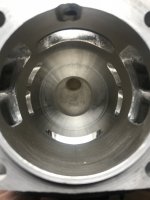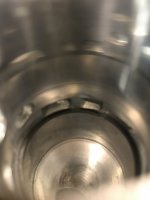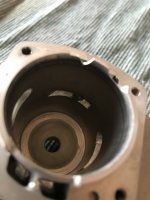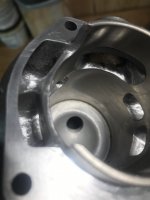So many awesome posts, going to address points w/o quoting people (to keep this as clear as I can!)
-
"Too-much compression": How much, is too-much? Jennings & Blair
both explain it as "a target", not "the more, the merrier", but that latter mindset is pervasive in chainsaw-building....could anyone help me understand this disconnect?
Too much compression hurts RPM's, yet I've not *once* heard a builder talk about how they
reduced compression (or, basically, did anything but maximize it...), and all I can conclude is that it's because chainsaws' compression-ratios tend to be way lower than, say, a dirtbike's (8:1, 10.5:1, not 13+:1),
ergo all chainsaws are inherently "way below" their optimal-performance compression-spec. Considering that hotter burns are more polluting (per HP generated), I don't have much trouble seeing/understanding that chainsaw OEM's comply to EPA guidelines by just keeping compression lower, but I can't reconcile that against the fact that racing dirtbikes
do have real high comp.ratios.....maybe it's just different, looser EPA restrictions in that category? I could see some (EPA-)logic in that kind of classification/distinction between engine-use-cases (recreational race versus daily-duty landscape gear)
- How does timing play into compression, if at all? I only ask because I've found nothing that directly connects the two (well, just that over-advancing is more dangerous when compression is higher),
but - like compression - advancement of ignition-timing is something that, in the chainsaw-performance world, it seems "it's always good". I've never once heard of someone
retarding their timing yet Jennings and Blair give the impression that, all else equal, if you went and say raise your exhaust roof (thus raising RPM), that you'd want to
retard your timing (yet the norm would probably still be to advance it, for instance my ported 660 woodruff is filed 20thou because that's what I heard recommended the most, I can't help thinking this was wrong but I don't have the means to properly test it) Think it was this forum, actually, that originated the idea (BLSnelling, IIRC) of timing advances via flywheel keyways, on an otherwise-untouched saw it should help but after reading more I keep getting an impression that on an RPM-advanced engine you would not want to advance the timing (maybe chainsaws come w/ such retarded timing, OEM, that
even with higher RPM from raised-exhausts you'd
still find yourself hitting peak cylinder pressure way too soon like 1deg past TDC, necessitating some advancement!)
- Compression #'s..... Is there any upper-ceiling for "plug-hole PSI" that you guys find yourselves adhering to, that you are intentionally refraining from exceeding this PSI? Or, in 9/10+ cases, is it "as much compression as I can
practically add while doing the build"? Seems this
is the case (which, again, makes me wonder why the OEM's would ubiquitously leave so much on the table, as stated perhaps EPA restrictions are harsher on OPE than on dirtbikes?)
- Spark plugs: Do any of you deviate from 'good regular plugs' (Champion Palladium etc) for other 'types' like wire type, high heat/cold plugs, etc? I know this isn't really comp.focused but very curious and is tangentially related

What about "types" of compression? Spark-plug PSI is all people seem to care about, giving me the impression it is the best yardstick for "general PSI", is this correct? I returned my gauge because I couldn't get consistent readings (and my stock 590 was hitting like 120psi, below oem spec, so knew I was not doing it right!)
But that ^ type of compression is almost "easily felt in the cord" at startup in my experience, and "good and high-comp" is as useful to me as some specific # PSI (as I've
no idea what I would do w/ that PSI, or how to directly alter it once a build's over, etc....decking and not over-doing exhaust roof are literally the *2* ways I'm aware of to influence compression, oh and pop-ups of course....I suspect timing-advancement may as well since it's building compression earlier which'd mean a plug-hole-PSI reading would be higher, I'd LOVE if anyone knows off-hand the point of rotation we want peak cylinder pressure? Wanna say it's like 10 or 20deg ATDC that peak pressure should be achieved)
How about bottom-end versus top-end displacement?
I hear people saying how a bigger bottom-end shifts powerband to peak higher in the RPM range of the engine (
not extending range just shifting, iirc) But then the other day I hear an anecdote about how some older 056/066 had a smaller crankcase and, if you put the newer/larger 660 head on it, it became a real thumper. This is in-contrast to how I understood it, am eager to learn more here! The books I read do seem to say that crankcases started getting smaller(in dirtbikes) in the 70's & 80's, that this was pushed "to the limit" w/ crankcase stuffing and all that....this'd lead me to think that, on a modern performance saw, that the crankcase/lower-end-volume is probably pretty dialed-in already, would love hearing any thoughts on this (in fact I cannot get it out of my head that my 660 big bore build worked better
because of piston, and lower-transfers, porting...because that porting opened-up the lower end "proportionately" to the increased displacement of the top-end)
//PS- I lol'd at a 2511 with a d-handle the other day, I mean at 25cc if you're having trouble you should get it on the bench and retard the timing because 25cc's of high-compression shouldn't be tough lol, but it's made me wonder what some of the smallest saws are you guys've
needed("greatly benefit from") a d-handle, if I'm being honest I always thought they were a fashion/aesthetic thing, or rather I know for fact they are, but now that a small Cerberus is trying to drop-start 100cc ported low-squish, now I have to wear a nitrile glove w/ the d-handle to even turn it on lol, so yeah am curious what CC's you guys' badass-build saws are needing d-handles, and would love hearing specific PSI #'s (both what you're getting, and stock or relative-to stock), everything I read says not to obsess on compression like chainsaw builders certainly
do, as mentioned I can't stop thinking that it's an EPA thing and simply an artifact of that (IE that Stihl, unlike Yamaha, has to come in under 11:1...)










